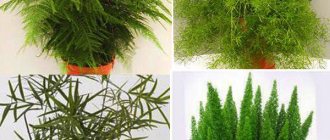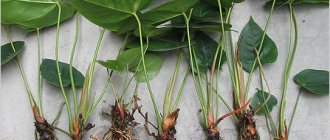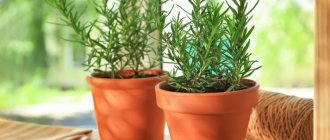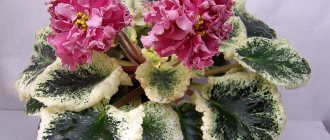Description and photo
The plant is a small shrub that branches as soon as it emerges from the root system. It grows 3-4 meters wide and reaches half a meter in height .
The central stems are straight, but bend under the weight. Numerous shoots emerge from them, covered with small and thin cladodes “needles” that look like plant leaves. Real leaves have the appearance of scales that are virtually invisible.
Meyer's asparagus - characteristic features of the plant
One of the many types of asparagus (there are more than 300 of them) grows as a herbaceous subshrub consisting of straight thick shoots. Their length can reach 1.5 m, and the diameter of the bush itself is almost 1 m. Such a “broad nature” is formed due to numerous small branches on the central branches. There are so many of them that it seems as if the shoots are covered with needles. At the same time, the side branches themselves are completely strewn with very small leaves in the form of scales. To complete the original look, the plant will surprise you with its rich green color, changing from light to darker tones. The root system is developed, consisting of fleshy thick roots.
With proper care, with the beginning of summer, small flowers bloom on the stems, among the side branches. They look like white bells. The diameter of each does not exceed 5 mm. At the end of flowering, fruits are set - burgundy oval berries with a diameter of up to 10 mm. Several seeds ripen in them.
Despite their decorative appearance, asparagus seeds can only be used for propagation. It is strictly forbidden to eat them due to their toxicity.
How is it different from other types?
The main difference from other species is that the shoots bend under their own weight and fall down, and usually reach about half a meter in length. The needles are arranged quite tightly and resemble a Christmas tree in appearance. This type of asparagus is especially loved by designers.
Read on our website also about other types of asparagus: pinnate, crescent, Sprenger.
Benefits and harms
The plant is used as decoration when making flower sets. Thanks to its beautiful lush shoots, it adds charm and splendor to bouquets. The picturesque flexibility of graceful branches looks great in hanging flowerpots.
Meyer's asparagus is used as a hanging plant. Flowering does not cause allergic reactions. To avoid poisoning, it should not be consumed as food for humans or animals. The plant is successfully cultivated indoors. It can often be found in the corridors of offices and schools.
Asparagus is found in regions of the European part of Russia, in the Caucasus and Kazakhstan. Read about the benefits, harm, diseases and cultivation of such types of asparagus as medicinal, white, Sprenger on our Internet portal.
Landing
- Choosing a pot. Asparagus produces many shoots, and the root system grows in breadth. Therefore, you should give preference to wide and deep pots.
- What should the soil be like? The plant needs loose soil with an alkaline reaction. An excellent option would be the following proportion 2: 1: 1: 1, consisting of turf soil, humus, leaf and river sand, preferably coarse-grained.
- How to plant? There are several ways to plant a plant: buy a ready-made cutting or plant a flower from seeds.
Soil preparation
If you decide to grow Meyer's asparagus from seeds, then it is better to prepare the soil for this yourself, especially since it is not at all difficult to do. Mix garden soil with vegetable humus in equal proportions and disinfect the mixture in the oven or freezer.
After this, warm the soil mixture under natural conditions to room temperature. Only after this can it be poured into the seed container. It should be wide and shallow.
Now moisten the soil mixture generously with a weak solution of manganese and leave for several hours to soak. Thus, not only insect larvae will be destroyed, but also harmful bacteria and viruses. Now you can start sowing the seeds.
Home care
- Temperature. The flower is accustomed to a relatively cool temperature of 20 to 22 degrees Celsius. If it is impossible to achieve such a temperature regime at home, then in the summer we take the plant to the balcony. In winter, the temperature is from 12 to 15 degrees, but it should not fall below 10.
- Lighting. If the plant is placed in a room, preference should be given to windows facing west or south. The flower prefers bright illumination, but it should be diffused. Do not place the plant in direct sunlight, which can harm the plant.
- Watering. During the summer season, which begins in spring and ends in autumn, it is necessary to keep the soil moist, but do not overwater the plant, otherwise it will rot. You must use water that does not contain chlorine. In winter, watering is reduced, and the top layers of the soil may even dry out.
- Feeding. Fertilizers should be used during active plant growth; mineral and organic additives are suitable. Microelements can be administered once every two weeks.
- Trimming. There is no need to prune the plant regularly. Only dried or dead shoots are removed. Trimming the plant will not cause more growth, but will most likely stop it.
- Transfer. The plant needs to be replanted in the spring. If the flower no longer fits in the old pot, then it is necessary to give preference to a vessel with a larger diameter and depth. When replanting, you cannot remove all the nodules, which are a source of nutrients for the plant. But to rejuvenate the root system, you can partially remove them.
- Care during the flowering period. If you do not need seeds, then after flowering the ovaries should be removed immediately to prevent the appearance of seeds. This will allow the plant to continue to grow without spending additional energy on maintaining the fruit.
- What to do if it doesn't bloom? Usually the cause of non-flowering is lack of proper care. It is necessary to identify the problem and fix it, for example, adjust the irrigation system or change the location to a sunnier one.
Reference! As much as you want to see buds on your favorite plant, you need to understand that asparagus flowering at home is a rare occurrence.
Uses of asparagus
Usually the plant is grown for indoor landscaping or creating beautiful, attractive bouquets. One woman grew asparagus to decorate the interior of her apartment, and her room became beautiful and cozy thanks to the flowerpot. To make it delight with its decorativeness, the woman created all the conditions for its cultivation, similar to the conditions of the seaside, natural climate.
Now you know how the Meyer variety of asparagus is planted, grown and propagated. It is important to provide the plant with proper care at home so that it can develop successfully and delight with its decorative effect and frequent flowering.
Features of reproduction
You can get a new plant in two ways: dividing the bush and growing from seeds.
Seeds should be planted in the second half of February or the first half of March.
Seeds are scattered into the prepared moistened soil, and cellophane is stretched over the container, creating a portable greenhouse. Seeds germinate in about three to four weeks .
Dividing the bush can be done throughout the year, but it is still better to do this before the start of the growing season.
Aftercare of young plants
The rooted new generation of asparagus needs to be fertilized with liquid complex fertilizers.
You must read the instructions carefully to administer the correct dose. Fertilizers are applied every two weeks. For better effect, you can alternate mineral or organic fertilizers. And in the summer, a one-time application of bird droppings is recommended, which will ensure the growth of young shoots for the plant. If you regularly spray young asparagus with “Bud” (1 gram of the drug per 1 liter of water), this will allow it to have a fluffy and bright crown.
Wilted or yellowed shoots can be pruned. It is also worth periodically removing bare stems; nothing else will grow on them. As a rule, pruning is carried out in the spring, when the plant is replanted. And it is necessary to transplant young plants into a more spacious pot every year until they reach the age of 5-6 years, and only after that you can relax a little and allow the plant to live in one container for 2-3 years.
Important! A healthy plant is not pruned.
From all of the above, we can conclude that propagating asparagus does not require much effort. By following all the recommendations, you can easily increase the number of copies of your pet.
Diseases and pests
The main pest of the plant is the spider mite, which settles between the needles of the leaves. At the same time, the plant does not tolerate chemicals that are commonly used to treat flowers in the presence of pests. In this case, we rinse the plant several times under warm water until all the pests are washed away. And then it is treated with diluted Actellik.
Attention! Dull leaves, lack of color, and falling needles are a clear consequence of improper plant care.
To identify the problem, you need to review the rules of care.
Sowing
The distance between seeds should be at least 3 centimeters. Lightly press them into the soil, and then cover them with a thin layer of the same soil mixture and moisten them. Cover the container or container with the seeds with glass or transparent film and place in a warm place with good lighting. This mini-greenhouse needs to be ventilated every day. At least twice a day, the soil should have access to fresh air for five, preferably ten minutes. Until the first shoots appear, moisten the soil systematically and do not allow its top layer to dry out. If the container is small in size, then the best place for it would be a window sill.
How long does it take for seeds to germinate? Usually amicably, if not simultaneously. You will see the first shoots in one to two weeks. The timing of their appearance depends on the condition of the seeds, air and soil temperatures and, of course, on the quality of the soil. To speed up the germination of seeds, they can be soaked in water before planting and left to swell for a day.
When sprouts appear, remove the film or glass from the greenhouse. From this time on, you can reduce watering, but do not allow the soil to completely dry out the top layer.
How to protect an Ethiopian guest?
The main prevention of diseases and problems arising with the plant is compliance with the rules of care and temperature conditions. It is also worth maintaining a balance when watering and applying mineral fertilizers. Regularly inspect the plant for pests, parasites and fungal diseases , which must be immediately treated and prevented at the stage of their appearance.
Regular watering, sufficient lighting, proper feeding and timely replanting, coupled with periodic inspection of the plant for pests, will provide your pet with everything necessary and Meyer’s asparagus will always please the eye with a healthy and beautiful appearance.
What to do if the decorative asparagus turns yellow and crumbles?
Despite the unpretentiousness and hardiness of asparagus, when growing it, inexperienced gardeners may encounter various diseases and problematic situations. Among these are possible:
- Spots on leaves.
- Dark edges.
- Shedding and yellowing of foliage.
- Pale color of the leaves.
- General wilting of the flower.
Each of the listed unpleasant cases has its own causes and methods of “treatment”.
So, in order to determine what to do when decorative asparagus turns yellow and crumbles, you need to identify unfavorable factors and eliminate them. In some situations, this will be enough to completely heal the damaged flower.
Hot temperatures and increased dry air are contributing factors to wilting and yellowing of the foliage of the bush. Therefore, the solution here involves a forced decrease in temperature and an increase in humidity using traditional methods and special devices.
An alternative solution would be to change the location away from the switched on battery or heater.











